DONATAS CHLEBINSKAS
MD, FEBOT, FRCS Orth
Orthopaedic Foot and Ankle Surgeon
Specializing in advanced arthroscopic and percutaneous techniques for foot and ankle conditions ranging from degeneration, deformity, diabetic foot to sports injuries and trauma


PASTARA - Posterior Arthroscopic Subtalar and Ankle Rod Arthrodesis for elderly and neuropathic ankle fractures VuMedi talk
On 04 Feb 2025 The international surgical video platform VuMedi published a talk on PASTARA - Posterior Arthroscopic Subtalar and Ankle joint Rod Arthrodesis for elderly and or neuropathic ankle fractures.
PASTARA is the technique proposed for frail elderly patients with Non Ambulatory Fragility Ankle Fractures (NAFF) with severe soft tissue envelope compromise.
Key aspects:
- NAFF ankle fractures should be treated with 36 hours from presentation
- Perform surgery with aim to allow immediate unrestricted weight bearing (GIRFT)
- Use PASTARA technique for elderly (over 65 and or severely comorbid) patients with severe soft tissue envelope compromise (blisters, severe swelling, skin atrophy)
- Consider this technique for patients with severe joint destruction, neuropathy, etc.
Technical tips
- Arthroscopic portals are established at the crossing point of the extended STJ and Ankle joint lines medially and laterally
- Hoke Tripple Achilles Hemisection to allow fusion in about 3 degrees of dorsiflexion
- aim for tibial isthmus fitting intramedullary hindfoot nail (wide diameter and sufficient length)
- use anterior calcaneotibial miss a nail screw
- apply back and U slab
- complete weight bearing cast next day

Our first Anatomical Arthroscopic ATFL and CFL reconstruction performed for Recurrent Chronic Ankle Instability
Me, our senior clinical fellow Mr. Nolan and the SEOC team have proudly performed first in the region arthroscopic Anatomical ATFL CFL reconstruction in December 2024. Primary ATFL CFL repair with or without augmentation remains a gold standard index procedure for chronic ankle instability. However for the patients with recurrent instability following primary repair, injuries with large avulsions, obese patients, elite athletes, hyper laxity, severely atrophic and irreparable remnant of the ruptured ligaments the anatomical reconstruction is indicated. We perform it arthroscopicaly to reduce the chance of wound complications.
Interesting fact*
- 150,000 anterior cruciate ligament of the knee (ACL) injuries are reported yearly in France
- 50,000 ACL reconstructions are performed yearly in France
- 2,000,000 lateral ankle sprains (LAS) are reported yearly in France
- 7000 ankle ligament surgeries are performed yearly in France
In the context of about 1/4 to 1/3 of ankle arthritis developing as a consequence of chronic ankle instability - this shows insufficient emphasis to treat ankle instability as a risk factor for future ankle arthritis.
Instability of the knee is fared of as a risk to develope painful arthritis needing a knee replacement. Societies offer treatment guidelines (BOAST) for surgeons to address this condition timely and efficiently to reduce potential future burden on health care service and society.
Ankle arthritis is not a less debilitating condition often requiring treatment ranging from braces to ankle replacement, ankle fusion or alternative surgery with its own risks. However no guideline by leading Orthopaedic surgery societies exists. Merely a consensus statement on ankle instability from 2013.
BOFAS patients guide states Less than one in 20 cases of
ankle instability need surgery, and 1 of 10 patients being not happy with their surgery discouraging patients from seeking surgical solutions. Consensus statement states that 20-30% (1 in 4-5) of ankle sprains results in ankle instability.
Controversy on the right way to surgically treat CAI also exists:
- Repair or Reconstruction?
- Arthroscopic or open?
- Is repairing ATFL and ignoring CFL sufficient?
- Augment with local tissues or with synthetic suture material?
Anatomical repair (Brostrom) - suturing ruptured or elongated ligaments to their fibular insertion point is used when the ligaments are preserved enough for repair.
Arthroscopic repair:
Pros
- FAI scores,
- AOFAS scores,
- lower wound complication rates,
Cons
- nerve injury risk
Arthroscopic Anatomical Ligament Reconstruction using tendon graft addresses both ATFL and CFL and is indicated in:
- failed previous repair
- Incompetent remnants of the ruptured ligaments
- >1cm fibular avulsion fragment
- hyper-laxity
- High athletic or laboral demand patients
- High BMI patients
Experience Excellence
Explore the expertise of consultant orthopaedic foot and ankle surgeon Donatas Chlebinskas MD.
Profile
Specialization Showcase
Discover the subspecialization description, procedures list, symptoms guide, and interesting cases blog.


Work Experience Section
Experience. With our intuitive design and user-friendly interface, your website will captivate visitors. 2
Orthopaedic Surgeon Profile
Consultant orthopaedic foot and ankle surgeon offering specialized procedures and personalized care.
Symptoms Guide Blog
Explore our blog for interesting cases, news from events, and a helpful symptoms guide.


Procedures List Prices
Browse our list of procedures with prices to find the best treatment for you.
Lithuanian English Version
Subspecialization Description




